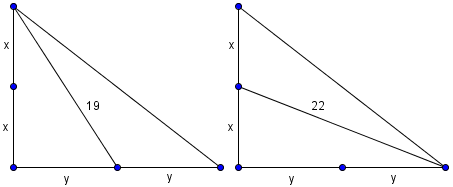Difference between revisions of "2002 AMC 12B Problems/Problem 20"
Ssrikanth123 (talk | contribs) (→Problem) |
Ssrikanth123 (talk | contribs) (→Solution) |
||
| Line 9: | Line 9: | ||
\qquad\mathrm{(E)}\ 32</math> | \qquad\mathrm{(E)}\ 32</math> | ||
| − | == Solution == | + | == Solution == |
[[Image:2002_12B_AMC-20.png]] | [[Image:2002_12B_AMC-20.png]] | ||
| Line 26: | Line 26: | ||
Alternatively, we could note that since we found <math>x^2 + y^2 = 169</math>, segment <math>MN=13</math>. Right triangles <math>\triangle MON</math> and <math>\triangle XOY</math> are similar by Leg-Leg with a ratio of <math>\frac{1}{2}</math>, so <math>XY=2(MN)=\boxed{\mathrm{(B)}\ 26}</math> | Alternatively, we could note that since we found <math>x^2 + y^2 = 169</math>, segment <math>MN=13</math>. Right triangles <math>\triangle MON</math> and <math>\triangle XOY</math> are similar by Leg-Leg with a ratio of <math>\frac{1}{2}</math>, so <math>XY=2(MN)=\boxed{\mathrm{(B)}\ 26}</math> | ||
| − | There is the solution, folks! Overall, this problem's topic is associated with the Pythagorean theorem. If you do not understand this solution, you should take a look at everything about Pythagorean theorem. Please contact us if there are any questions, concerns, or doubts | + | There is the solution, folks! Overall, this problem's topic is associated with the Pythagorean theorem. If you do not understand this solution, you should take a look at everything about Pythagorean theorem ad triangles. Please contact us if there are any questions, concerns, or doubts about this problem, and we will take a closer look at our solution. |
| − | + | I hope you have a wonderful day! Thank you. | |
== See also == | == See also == | ||
Revision as of 15:24, 21 June 2018
- The following problem is from both the 2002 AMC 12B #20 and 2002 AMC 10B #22, so both problems redirect to this page.
Problem
Let ![]() be a right-angled triangle with
be a right-angled triangle with ![]() . Let
. Let ![]() and
and ![]() be the midpoints of legs
be the midpoints of legs ![]() and
and ![]() , respectively. Given that
, respectively. Given that ![]() and
and ![]() , find
, find ![]() .
.
![]()
Solution
Let ![]() ,
, ![]() . By the Pythagorean Theorem on
. By the Pythagorean Theorem on ![]() respectively,
respectively,
![]()
Summing these gives ![]() .
.
By the Pythagorean Theorem again, we have
![]()
Alternatively, we could note that since we found ![]() , segment
, segment ![]() . Right triangles
. Right triangles ![]() and
and ![]() are similar by Leg-Leg with a ratio of
are similar by Leg-Leg with a ratio of ![]() , so
, so ![]()
There is the solution, folks! Overall, this problem's topic is associated with the Pythagorean theorem. If you do not understand this solution, you should take a look at everything about Pythagorean theorem ad triangles. Please contact us if there are any questions, concerns, or doubts about this problem, and we will take a closer look at our solution.
I hope you have a wonderful day! Thank you.
See also
| 2002 AMC 10B (Problems • Answer Key • Resources) | ||
| Preceded by Problem 21 |
Followed by Problem 23 | |
| 1 • 2 • 3 • 4 • 5 • 6 • 7 • 8 • 9 • 10 • 11 • 12 • 13 • 14 • 15 • 16 • 17 • 18 • 19 • 20 • 21 • 22 • 23 • 24 • 25 | ||
| All AMC 10 Problems and Solutions | ||
| 2002 AMC 12B (Problems • Answer Key • Resources) | |
| Preceded by Problem 19 |
Followed by Problem 21 |
| 1 • 2 • 3 • 4 • 5 • 6 • 7 • 8 • 9 • 10 • 11 • 12 • 13 • 14 • 15 • 16 • 17 • 18 • 19 • 20 • 21 • 22 • 23 • 24 • 25 | |
| All AMC 12 Problems and Solutions | |
The problems on this page are copyrighted by the Mathematical Association of America's American Mathematics Competitions. 










